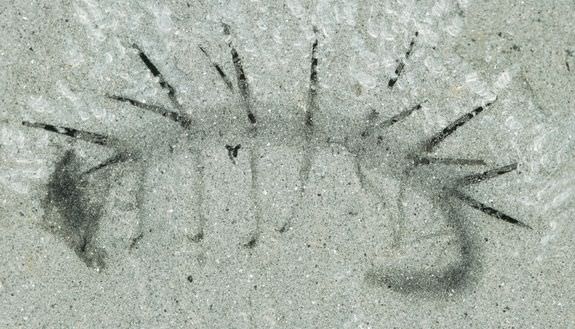A 505-million-year-old fossil worm called Hallucigenia sparsa has been identified as the progenitor of modern-day velvet worms, described by the Christian Science Monitor as “strange, sluglike creatures with centipede-style legss.”
The affinity of Hallucigenia and other contemporary ‘legged worms’, collectively known as lobopodians, had been very controversial, as a lack of clear characteristics linking them to each other or to modern animals has made it difficult to determine their evolutionary home.
Early interpretations of Hallucigenia, which was first identified in the 1970s, placed it both backwards and upside-down. The spines along the creature’s back were originally thought to be legs, its legs were thought to be tentacles along its back, and its head was mistaken for its tail.
Hallucigenia lived approximately 505 million years ago during the Cambrian Explosion, a period of rapid evolution when most major animal groups first appear in the fossil record. These particular fossils come from the Burgess Shale in Canada’s Rocky Mountains, one of the richest Cambrian fossil deposits in the world.
Looking like something from science fiction, Hallucigenia had a row of rigid spines along its back, and seven or eight pairs of legs ending in claws. The animals were between five and 35 millimetres in length, and lived on the floor of the Cambrian oceans.
A new study of the creature’s claws revealed an organisation very close to those of modern velvet worms, where layers of cuticle (a hard substance similar to fingernails) are stacked one inside the other, like Russian nesting dolls. The same nesting structure can also be seen in the jaws of velvet worms, which are no more than legs modified for chewing.
While Hallucigenia had been suspected to be an ancestor of velvet worms, definitive characteristics linking them together had been hard to come by, and their claws had never been studied in detail. Through analysing both the prehistoric and living creatures, the researchers found that claws were the connection joining them together.
Cambrian fossils continue to produce new information on origins of complex animals, and the use of high-end imaging techniques and data on living organisms further allows researchers to untangle the enigmatic evolution of earliest creatures.
Agencies/Canadajournal

 Canada Journal – News of the World Articles and videos to bring you the biggest Canadian news stories from across the country every day
Canada Journal – News of the World Articles and videos to bring you the biggest Canadian news stories from across the country every day

